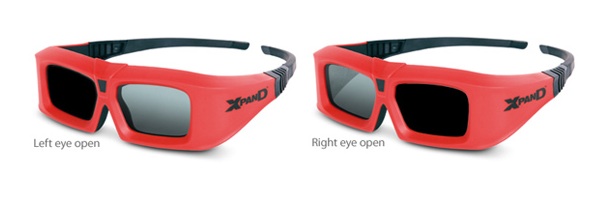By Ray Bennett
Technology firm XpanD is marching its active-shutter 3D systems around the world and partnered with several top manufacturers it’s heading into the home with universal glasses.
When you invite your friends over to watch a big game or blockbuster movie on 3D, it won’t be “Bring your own bottle”; it will be “Bring your own glasses!”
That’s what international technology firm XpanD hopes, anyway, and given the inroads they’ve made into the market and their marketing savvy, you wouldn’t bet against them.
XpanD manufactures 3D technology for cinemas and home entertainment using the active shutter system. In August, XpanD will launch its X103 3D universal glasses designed to work with LCDs, DLP and plasma displays.
The firm, which has offices in Slovenia and Los Angeles, has equipped 3,000 screens around the world with active 3D and installed its system in the 3D players hitting the market from Panasonic, Sony, Phillips and other high-end consumer electronics manufacturers.
James Cameron is a big fan of active-shutter technology and XpanD equipped ArcLight Cinemas’ flagship Los Angeles movie theatre, Cinerama Dome, for the launch of “Avatar”. According to XpanD CEO Maria Costeira, the quality proved so popular that ArcLight decided to keep it.
Costeira is passionate about content and 3D, and especially about her company’s universal glasses. “They are extremely light, at the point of today’s technology they cannot go much lighter than this, and the response has been more positive than our wildest hopes,” she says.
The glasses will retail for $129 in the United States with recommended prices elsewhere, including the UK, dependent upon taxation and transportation. Costeira says they will last as long as an LCD television and the standard batteries will last for more than 200 hours. Care and protection are the same as for prescription spectacles. Unlike the ones at the cinema, these fold away like ordinary glasses. They are not, however, ordinary glasses.
XpanD Chief Strategy Officer Ami Dror explains that they work by alternating images. “The lenses are completely shut or completely transparent and they alternate very fast. In the cinema at 144 times per second and in the home at 120 times per second,” he says. “The good thing about it is there is nothing physical between the image and your eye. All the other systems require some filtering.”
Unlike other 3D systems, this one does not require a silver screen and so the image has very high brightness with no ghosting, says Dror. That’s significant because a silver screen is like a mirror and so it magnifies light, meaning that those sitting in the middle of the theatre will get too much brightness and hotspots while those to the side have diminishing returns. Dror insists that doesn’t happen with active-shutter technology.
“You can watch 10 minutes of 3D with ghosting with no problems, maybe there’s some shadowing. But when you watch for an hour you have eye fatigue. Your brain starts to get tired and then it creates headaches. The only reason you have a headache is because of those passive systems,” he says.
The company claims to have 100% of the market in Asia, about 50% in Europe and just 10% in the US where competitors such as RealD and Dolby dominate with passive 3D systems that use polarised glasses. Dror says, “US cinemas resisted us because they have to buy it, they don’t get it for free like a passive system. In the long run, the active process costs them less but with the credit crunch buying a system was maybe not an option. But it’s like buying furniture. I can give you a plastic seat, or I can give you a proper couch. You choose.”
He says that Panasonic approached XpanD three years ago to develop 3D TV for its products. “We worked with their technical team and at the Consumer Electronics Show, when they showed their 103 inch TV, that was all XpanD technology and XpanD glasses. We did the entire development for Panasonic, and when people saw the product they said, ‘We have to do it!’ Sony, everybody, except JVC,” Dror says.
But with 20 odd manufacturers entering the 3D market, XpanD spotted a need for universal glasses. “If I have a Samsung TV in my living room and a Sony TV in the bedroom, I need to buy 3D glasses for each one,” he says. “But 3D is not there so we can watch the news, it’s for movies, games and sport. Say you want to watch the Champions League final and you invite 10 friends. You have two options. You can go to a shop and buy 10 pairs of glasses or just tell everyone to bring their own.”
He says it’s no different to having a universal remote control for all the home entertainment units. “When we spoke to Best Buy and all the big chains, they told us they don’t have the shelf space to carry 20 different types of glasses. They were all looking eagerly for one pair of glasses to work with all 3D TVs, PCs, laptops, Blu-ray players and at the cinema,” says Dror.
Costeira says it’s important that consumers have an easy way to watch 3D. “I come from the service industry, and the customer is very important. If he goes away, he doesn’t come back,” she says. “This is not just a pair of glasses. It’s high-tech so there are a lot of conditions in the equation. But the manufacturers, the retailers, they’re all committed to the same thing. It’s a win-win situation and the end-user is happy. Make it a theatrical experience, a Blu-ray or TV or games experience. Let’s make sure the customer is happy today … and tomorrow!”
This story appeared in Cue Entertainment.

